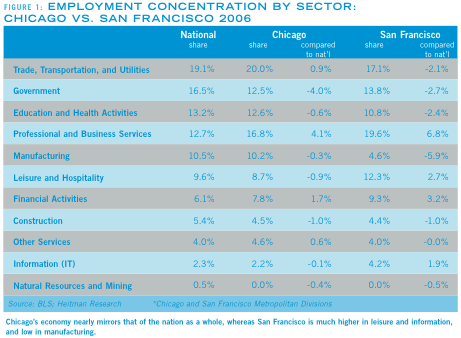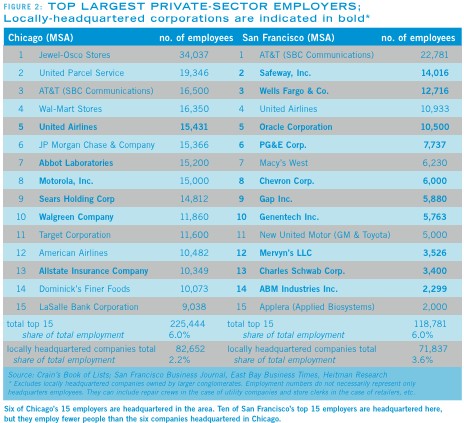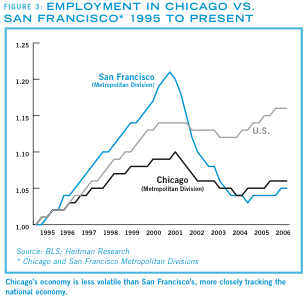Chicago no longer fits its long-standing Rust Belt image. The city's skyline glistens with shiny new office towers, centerpieces for a revitalized urban core. Out in the suburbs, sprawling office parks - as well as mixed-use developments - conjure those of California, with maple trees standing in for palms.
But Chicago is not San Francisco. In many ways, Chicago has stayed close to its roots. Transportation is the city's most important industry, and manufacturing still plays a large role, even in the face of stiff international competition. On the flip side, Chicago lacks much of the innovative commerce that defines other cities. It was spared the brunt of the dot-com bust because it had few dot-coms to begin with.
Chicago's economy differs from that of San Francisco mainly in that it is not as special. Its economic structure is similar to that of the nation as a whole, with comparable distributions of employment across industries. Chicago's economy tends to be neither more nor less volatile than the national economy. Owing to Chicago's relative economic maturity, its rate of economic growth has been lower than the national rate. The Chicago region's economic development authorities have embraced its broad-based economic profile, working to attract all types of economic activity rather than focusing on a particular target sector.
A DIVERSE ECONOMY
Figure 1 shows employment concentrations by industry sectors in Chicago and San Francisco, with a comparison to the nation as a whole. For the most part, variations from the national averages are greater for San Francisco than for Chicago. For example, 4.6 percent of San Francisco's jobs are in manufacturing, 5.9 percentage points less than the national share of jobs in that sector. Chicago's concentration of manufacturing industry, on the other hand, is nearly in line with the national average.

Both Chicago and San Francisco have high concentrations of employment in the FIRE industries (finance, insurance and real estate), as well as business and professional services, which include law and accounting. Chicago's strength in the financial world is buoyed especially by its two major exchanges, the Chicago Board of Trade and the Chicago Mercantile Exchange, which have helped make Chicago the world's center for derivatives trading.
Despite Chicago's strength in the convention industry, San Francisco has a higher employment concentration in leisure and hospitality, driven largely by tourism. San Francisco also has a much higher share than Chicago of employment in the information technology sector, reflecting the Bay Area's concentration of high-technology industries.
Figure 2 shows the 15 largest private-sector employers in the Chicago and San Francisco MSAs.

While both Chicago and San Francisco are home to corporate headquarters, Chicago is more reliant on several very large companies. Six of the Chicago MSA's top 15 private-sector employers are headquartered in the area, and have about 83,000 employees in total, whereas 10 of San Francisco MSA's top 15 employers are locally headquartered but have only 72,000 employees. In Chicago, United Airlines, Abbot Laboratories, Motorola, Sears, Walgreens and Allstate each employs more than 10,000 in the area, and each has a sprawling suburban corporate campus. By contrast, of San Francisco's 10 locally headquartered firms, only three have more than 10,000 employees.
SLOW AND STEADY WINS THE RACE?
With a diverse economic base and a tendency toward larger firms, Chicago's economic growth is constrained on both the upside and the downside. The comparison with San Francisco, whose technology industries are particularly volatile, is striking. Figure 3 shows an index of total employment in the Chicago and San Francisco Metropolitan Divisions, with the level of employment at the beginning of 1995 equaling 1.00.

Between 1995 and 2000, the San Francisco economy added 190,000 jobs, an increase of 21.0 percent. Over the same period, Chicago added 340,000 jobs, an increase of just 9.5 percent. After the bursting of the dot-com bubble and Sept. 11, San Francisco's economy crashed. The San Francisco Metropolitan Division lost 159,000 jobs between the end of 2000 and mid-2004. Chicago's landing was softer - it shed only 169,000 jobs, which represents much a smaller loss on a percentage basis. Net job growth over the past 10 years was actually higher in Chicago than in San Francisco, as San Francisco's bust erased nearly all the gains of its earlier boom.
INLAND PORT CHICAGO
One of the most important moderating, steady-growth forces in the Chicago economy is the transportation industry. While O'Hare International Airport is the nation's largest airline hub, it is not air transportation that has the greatest impact on the region. In the 19th century, railroads made Chicago the capital of the nation's trade in hogs and beef cattle. Today, intermodal rail transportation has solidified the Chicago's role as the nation's most important distribution center.
More Class I railroads come together in Chicago than in any other city. The Union Pacific, BNSF, CSX, Norfolk Southern, Canadian National and Canadian Pacific all have lines in and out of the region. According to some estimates, more than 75 percent of U.S. rail freight passes through Chicago's rail yards. Each day, more than 1,300 freight trains with 39,000 carloads of rail freight, or 25 million tons, originate in the Chicago region.
The most economically significant rail freight handled in Chicago consists of shipping containers arriving from costal ports. These containers are sent to Chicago by rail so that their contents can be distributed throughout the country. Figure 4 shows container volumes on U.S. railroads in 2004. The thickness of each line is proportional to the number of Twenty-Foot Equivalent Units, or TEUs, a standardized measure of container volume, carried on that route.

While there is a smaller amount of reliable data on the number of containers handled by inland locations than for ocean-based ports, logistics experts estimate that the container volume into and out of the Chicago area totaled about 15 million TEUs in 2004. This effectively makes it a larger container "port" than Los Angeles and Long Beach, which together handled about 13.1 million TEUs. In fact, if all of the containers that arrive in Chicago by train were counted as if they were handled by a water port, Chicago would be the world's third-largest port after Hong Kong and Singapore.
The impact of Chicago's transportation dominance can be seen in the depth of its distribution employment and industrial real estate market. In 2005, there were approximately 306,000 employees in the Chicago area directly employed in the distribution industry. Most of these jobs were in large distribution centers. Of Chicago's nearly 1 billion square feet of industrial space, 490 million square feet is warehouse space, the largest stock of distribution space in the country. The Chicago area has more than 300 warehouse buildings with greater than 400,000 square feet of space. The massive new BNSF CenterPoint Intermodal Center, an intermodal rail facility located just south of Joliet, Ill. in the southwest suburbs, has attracted the development of distribution centers with very large footprints. Some of these facilities surpass 1.5 million square feet in size.
ECONOMIC DEVELOPMENT
While some regions' economic development authorities have tended to focus on a few "hot" high-growth industries such as biotech or nanotechnology, Chicago's broad, diversified economy, has meant that the region's economic development efforts have also been broad and diversified. The region's most prominent economic development agency is World Business Chicago, which was founded by current Mayor Richard M. Daley but works with companies on locating throughout the region. World Business Chicago's sales pitch focuses on Chicago's vast market, centrality, infrastructure and quality of life.
For better or for worse, the economic development authorities of the City of Chicago and State of Illinois have been among the most aggressive in the country in offering incentives for companies to locate high-profile operations or corporate headquarters in the region. The most famous (or infamous) incentives deal was the $63 million Boeing headquarters relocation of June 2001. As a result of the deal, Boeing moved just 500 employees - top corporate brass and their support staff - from Seattle to Chicago. But supporters say that the relocation was worthwhile because it elevated the profile of Chicago on the world stage.
A less well known but larger incentives deal better encapsulates Chicago's economic strategy. In September 2000, Chicago brokered a $115 million package of state and local incentives to keep a Ford automobile assembly plant from moving to Georgia. The deal links a commitment to develop an industrial park for Ford suppliers with a plan to convert more than 900 acres of abandoned, contaminated manufacturing land on the city's low-income, mostly African-American Far South Side into an intermodal transportation center. Working with a private real estate developer, Chicago paid to improve the site and build the supplier park, while Ford paid to upgrade its own facility. A far cry form the typical one-off automotive plant deal, the Ford project leverages demand for parts created by Ford's plant and Chicago's transportation infrastructure to create, it is hoped, nearly as many new third-party jobs as were saved by retaining the factory.
Despite the newly polished glitz of downtown, Chicago is a slow but steady kind of city. Its economy has experienced neither the ups nor the downs of San Francisco. But owing to its industrial diversity, key transportation role and broad-based economic development efforts, Chicago has emerged as a global city and the definitive economic stand-out of the Midwestern region. While the new office towers downtown may inspire commentary on the knowledge-centric "post-industrial city" a trip outside the core reveals vibrant manufacturing activity and dozens of bustling intermodal rail yards.